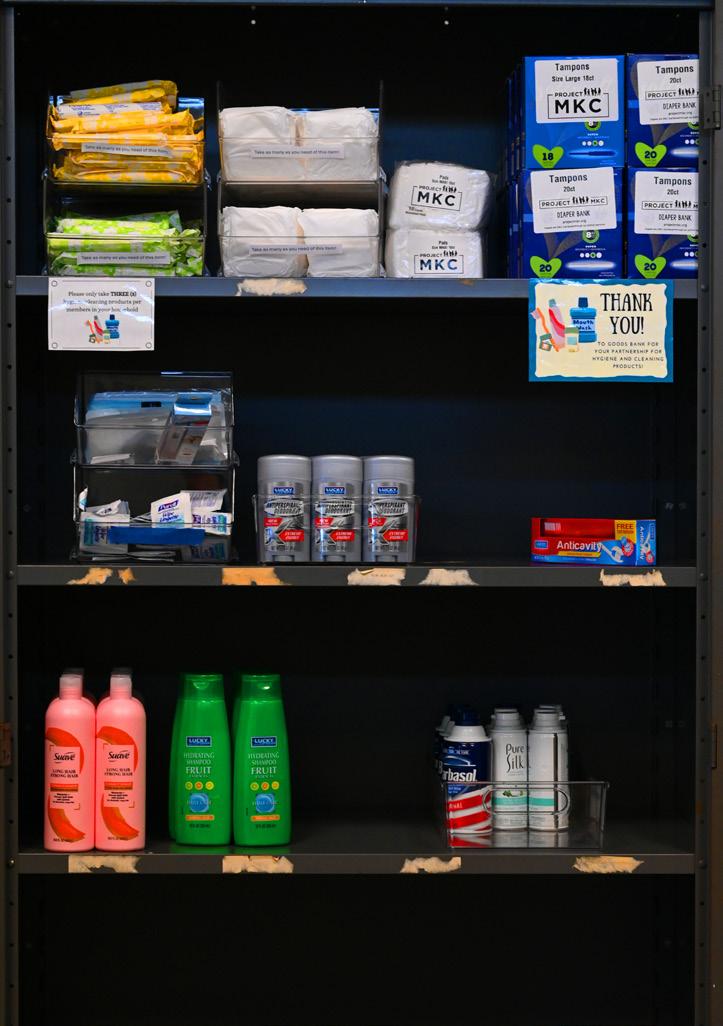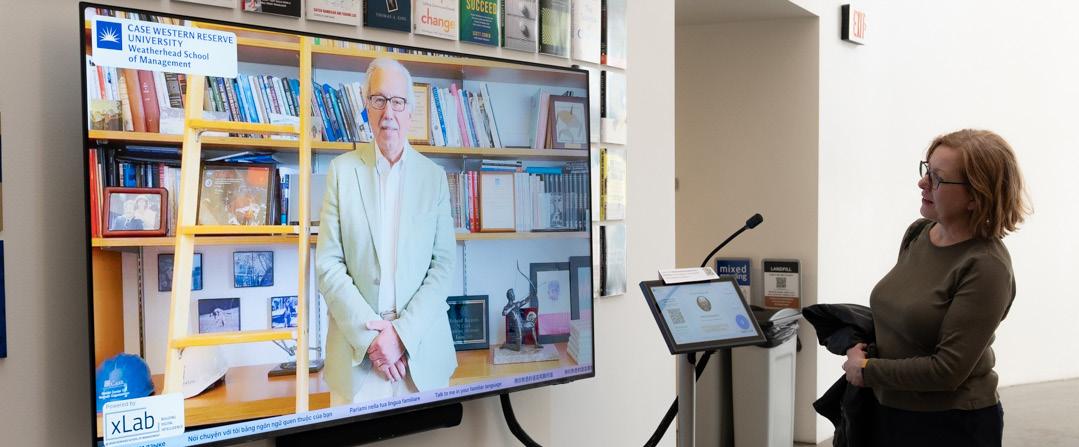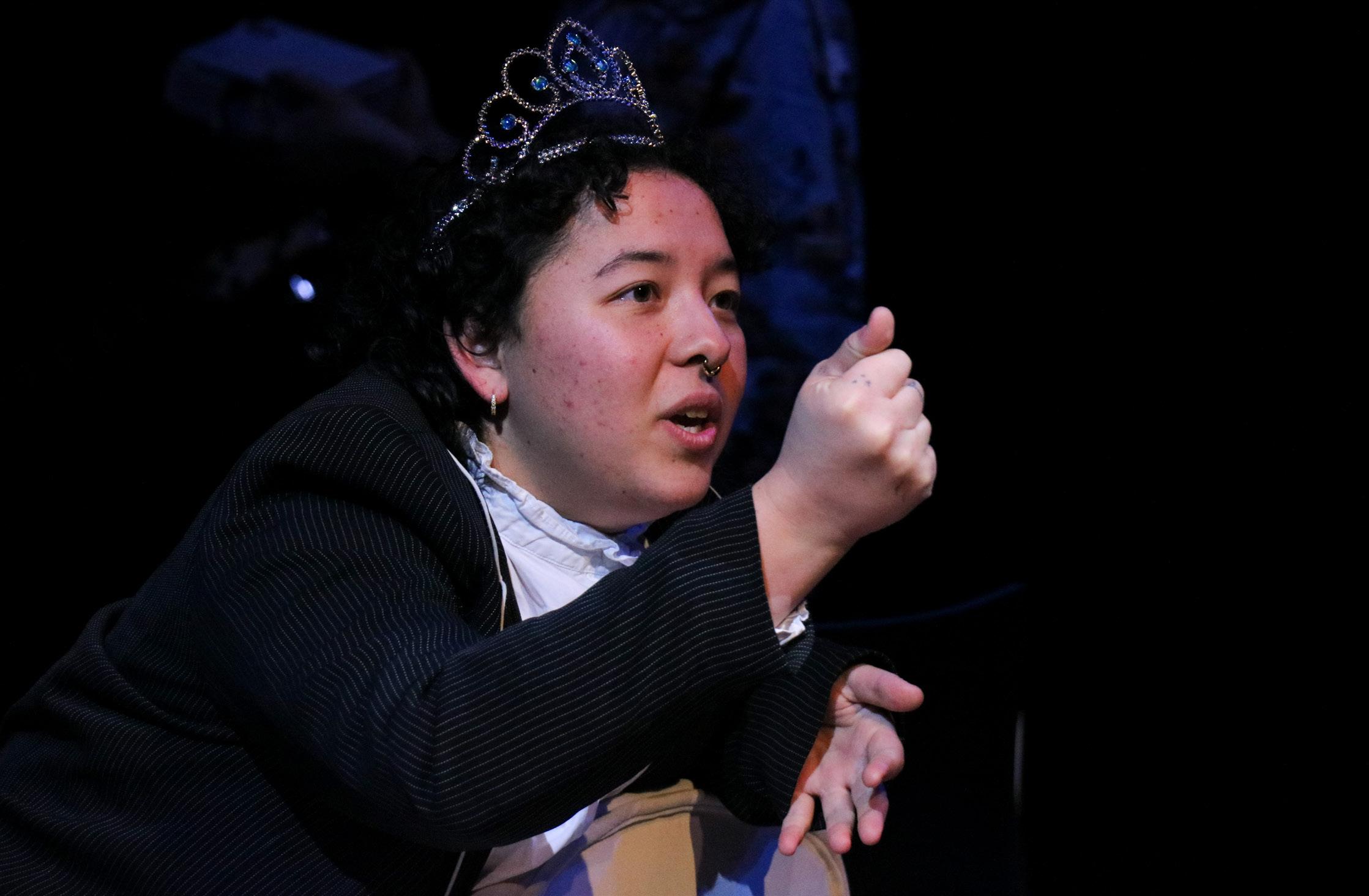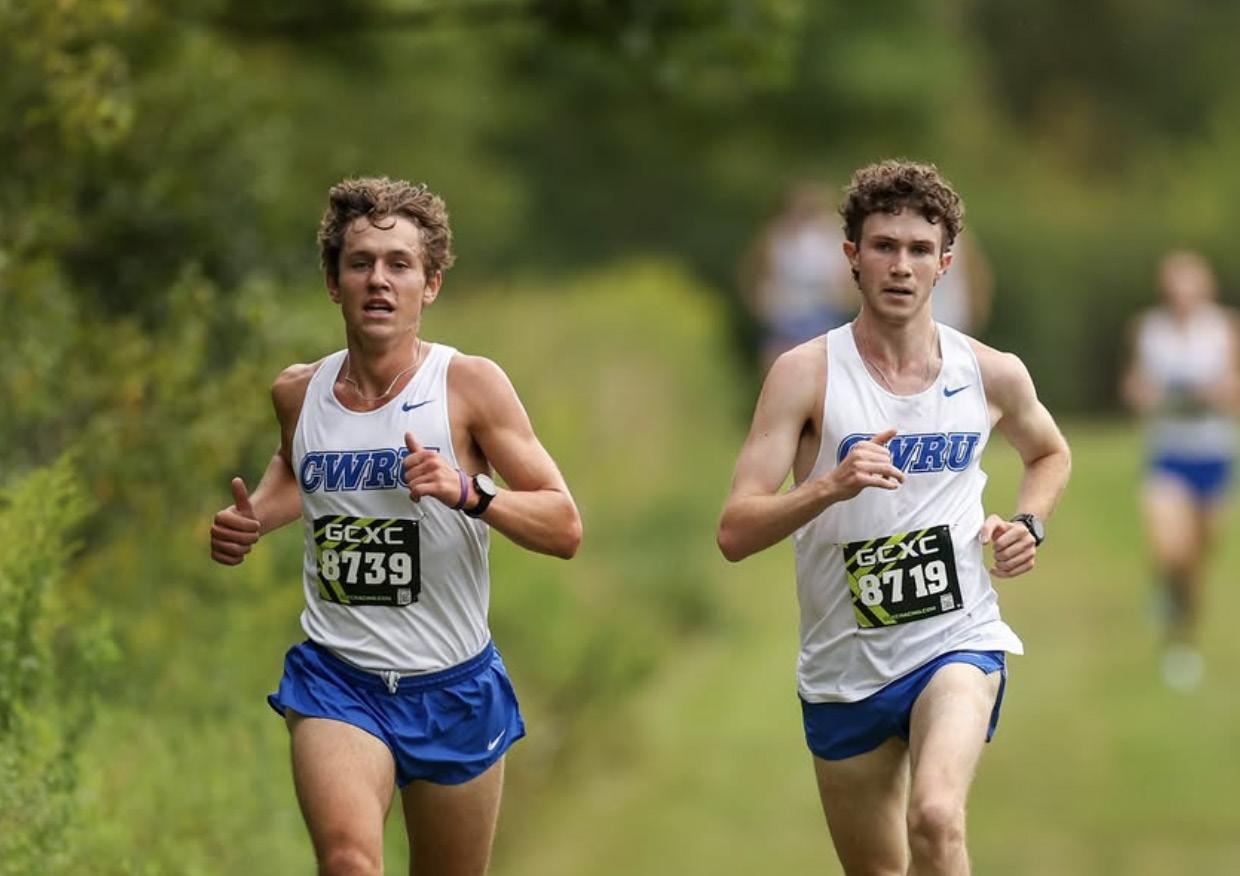Observer The Case Western Reserve
Friday, November 7, 2025

Friday, November 7, 2025

On Nov. 1, no federal food assistance programs were distributed to Americans. The means to fund for SNAP (Supplemental Nutrition Assistance Program) and WIC (nutrition assistance for Women, Infants, and Children) programs, which families around the country depend on for food assistance, “ran dry”, as described on the USDA website on Oct 26.
In the face of the approaching deadline, Ohioans took action. People shared information about where to find local resources, and food banks prepared for the influx of people who depend on the food. Then, on Thurs

ine signed an executive order for the Ohio Department of Jobs and Family Services (ODJFS) to give $7 million to regional food banks and up to $18 million in emergency relief benefits to more than 63,000 low-income families.
First, DeWine’s executive order requires ODJFS to allocate $7 million to regional food banks using Temporary Assistance for Needy Families (TANF) funds. Also, the order requires ODJFS to double the monthly benefit for the state’s 63,000 Ohio Works First recipients — which include more than 57,000 children. Ohio Works First provides assistance to low-income families with children at or below 50% of the federal poverty level (the poverty level is $15,650 for a single person or $32,150 for a family of 4) using TANF funds. The $25 million-dollar-total pales in comparison to the total of $264 million in SNAP benefits about 1.4 million Ohioans received every month.
Food banks across the state prepared for an influx of people as Nov. 1 approached. For instance, the Greater Cleveland Food Bank (GCFB) serves Cuyahoga, Lake, Ashtabula, Ashland, Geauga and Richland counties. In an interview prior to Nov. 1, Karen Pozna, GCFB Director of Communications and Special Events told the Observer, “No food bank can really make up for the lack of SNAP benefits. For every meal distributed by a food bank, SNAP provides nine meals.” Anticipating the difficult times ahead and for Clevelanders depending on the food bank, she said, “It is going to be a challenge.”
In addition to sending state funds to food banks and individuals at risk, Cuyahoga county stepped up to support its residents. As of Oct. 31, a variety of Cuyahoga County philanthropic,
civic and corporate leaders joined together to raise more than $600,000 for the GCFB. Among the community partners that made significant contributions were the City of Cleveland, The Cleveland Foundation and all three Cleveland professional sports teams. Mayor of Cleveland Justin Bibb said in a statement that, “The City of Cleveland will not stand by while our residents face hunger.”
Cleveland-based nonprofit Foodstrong also plays a major role. “What is going on right now is exactly why we do what we do,” said Sara Continenza, Founder and Executive Director of Food Strong. “We are teaching food sovereignty, so that people don’t have to depend on food banks.” “We never know when a program like SNAP or a food bank will be underfunded. We teach people how to fend for themselves,” Continenza stressed.
On the Case Western Reserve University campus and for community members living in University Circle, there are other resources. Student organizations on campus have been continuously working towards stronger food security. One club, Food as Medicine, is a 501(c)(3) student-run organization dedicated to advocating for food as a form of preventative medicine, particularly emphasizing disease prevention and overall physical well-being. Their mission is to “provide opportunities for students to participate in community service and lead hands-on nutrition education sessions that emphasize interaction and engagement.“
There are many opportunities for students to get involved in improving food insecurity in Cleveland. Food as Medicine “welcomes any student who wants to get involved in nutri-
tion education or community engagement, regardless of their background,” stressing that students do not need to be experts in nutrition, but “what matters most is a willingness to help and engage with the community.” Both the Greater Cleveland Food Bank and Food Strong welcome volunteers. GCFB invites people to make donations. Students can learn more at the organizations’ websites, greaterclevelandfoodbank.org and foodstrong.org respectively.
Anyone experiencing hardship due to food insecurity should refer to: The CWRU Basic Needs Hub and CWRU Community Pantry
The Greater Cleveland Food Bank and a variety of other local resources, many of which are listed in Cleveland.com’s “Greater Cleveland food pantry locations 2025: County-by-county resource guide” article published Oct. 30.

Sabrina Feldberg News Editor
On Oct. 31, the Ohio Redistricting Commission (ORC) drew a new congressional map. The drawing gives the Republican party a boost in gaining two more seats in the upcoming 2026 midterm elections.
The census calls states to redraw their maps every ten years due to population changes. In Ohio, the previous map did not receive bipartisan support from the state legislature in 2022; it was approved with only a simple majority. Under Ohio law, maps that lack bipartisan support are only valid for two general elections rather than ten years, so congressional district maps needed to be redrawn in four years instead.
By Oct. 31, the ORC had to decide on a map with bipartisan approval to prevent it from returning to the legislature for another vote. The fact that the ORC was able to secure the decision before the redrawing was passed to the Republican-dominated legislature provided more fairness to Democrats. The redistricting commission’s decision was unanimous, leaving the Republican Party with two more redleaning districts than their previous 10 out of 15, giving them a 12-3 advantage over Democrats.
Brian Pearson is the executive secretary of the North Shore American Federation of Labor and Congress of Industrial Organizations (AFL-CIO), Ohio’s most active and largest labor council. While referring to the Democrat’s current minority standing, he said, “I think the Democrats had to take the deal on the table or the Republicans could have made it much worse.”
Despite the Republican majority, many believe that Democrats were given the most favorable outcome, given
their minority status in the Trump administration. Republicans dominate both the State Senate and the House, comprising a majority of the redistrict-
the moment, which means they have an advantage redrawing lines,” Buchler said. He emphasized that “nothing is permanent” in these kinds of

Republicans with a “seat-vote gap,”—a larger portion of seats than representative of those who affiliate with their party in the state.
Justin Buchler, an associate professor in the Case Western Reserve University department of political science, described the partisan bias at play.
“The Republicans have an advantage at the level of state government at
“The punishment for stupidity is that eventually you lose, which is why no one holds a long-term majority.”
Recently, President Donald Trump has been pushing states to gerrymander to become more Republicanleaning. In gerrymandering, states intentionally redraw their maps before the ten-year census in the hopes of gaining an advantage in upcoming elections for a certain political party.
Even though Ohio redrew lines under a specific plan to gain full bipartisan
support, the drawing shows bias. Buchler described how the “game” started in Texas.
“This [gerrymandering] process began with Texas, with an attempt by the Texas GOP to pick up a few more Republican seats through mid-decade redistricting,” Buchler said. He discussed how the Democratic party attempted to cancel out the gains in Texas in response to the pre-census redistricting. “Everyone else is trying to cancel out the other party’s response, and the effects cannot be assessed in isolation.”
The Democratic incumbents who plan to run for re-election face different changes in pressures now.
The incumbents include Greg Landsman who is running for the 1st congressional district, Marcy Kaptur for the 9th and Emilia Sykes for the 13th. Landsman faces a more Republican-dominated district, but his odds are uncertain given its less red-leaning outcomes in recent years. Kaptur faces her district’s expansion to a red-leaning northwest Ohio, leaving her at a potentially greater disadvantage. In a surprising win for Democrats, Sykes deals with a more blue-leaning district.
“I am confident we will be at 11-4 at a minimum which is better math than 13-2 or 12-3,” Pearson said regarding the Democrat’s chances in the upcoming midterm election.
Given the changes, Kaptur faces what Pearson has called a “tougher race.” However, Kaptur, who is the longest-serving woman in the history of Congress, shows no signs of being ruffled by redistricting tactics. She responded to the changes in a statement.
“I remain committed to serving Northwest Ohio and will seek re-election with a renewed focus on accountability and protecting the voice of the people,” she said. “Our democracy works best when voters choose their leaders, not when politicians choose their voters.”
Sabrina Feldberg News Editor
This October, the Weatherhead School of Management added a new AI Avatar Kiosk featuring the likeness of four Weatherhead professors. It was built this summer with xLab by a group of students, led by a second-year MBA student. The avatar kiosk offers interactive guidance to students.
There are three main components of the AI system. First, the kiosk has an interface which allows users to connect to a voice stream and AI video avatars. Second, it uses a real-time content generation engine powered by large language models that use previous lectures, courses and publications from the professors to provide contextual accuracy and create a life-like impression of the professor. Lastly, a backstage management platform allows new professors to be feasibly added to the educators featured in the kiosk.
“The goal for this kiosk is to showcase our faculty thought leadership and depth of knowledge in an interactive display, while also showcasing the types of projects students have the opportunity to work on while at Weather-

head,” Dean of Weatherhead School of Management Andrew Medvedev said.
The interactive and accessible kiosk provides high-quality information without the use of a 24/7 server. It challenged students to create a system that could reliably and continuously function throughout the day. Medvedev discussed the obstacles the group faced while constructing the hardware
and software of the kiosks.
“On the software side, the team spent a lot of time designing a system that’s easy to maintain using a serverless architecture,” Medvedev said. “On the hardware side, they had to carefully tune and integrate components to ensure everything was running smoothly without interruption. The students even built a native macOS ap-
plication specifically to host the kiosk’s web interface, locking it down so users can’t easily exit the experience.”
Medvedev described what he hopes students will take away from the interactive experience. “[It] is a tangible example of students moving beyond the role of users of emerging technologies to becoming designers and builders of them.”
Alyssa Wang News Editor
On Nov. 4, millions of Americans nationwide cast their ballot in a highly contested election. During this year’s general election, voters eagerly watched as the counts of many states flowed in, including New York, New Jersey, Virginia and California.
State Assemblyman and democratic socialist Zohran Mamdani ran against former Governor Andrew Cuomo—a Democrat who ran as an independent—and Republican candidate Curtis Sliwa. Mamdani will make history as New York City’s first Muslim and South Asian mayor, as well as the youngest to hold the office in more than a century. His plans include a four-year rent freeze on rent-stabilized apartments to combat the high cost of housing, free public buses, lowered cost of childcare, increased


Abigail Spanberger—former congresswoman, CIA agent and moderate Democrat—will be the first woman to serve as governor. She defeated incumbent Lieutenant Governor Winsome Earle-Sears with 57.2% of the vote. Democrat Ghazala Hashmi won Virginia’s lieutenant governor’s race, making her the first Muslim woman elected statewide. Hashmi will vacate her seat in Virginia’s State Senate and instead lead Senate sessions, breaking ties if needed.
U.S. Representative and Democrat Mikie Sherrill faced Republican Jack Ciattarel li, who had President Donald Trump’s endorsement. She was elected as New Jersey’s 57th governor and second female leader. Sherrill is a former Navy helicopter pilot and federal prosecutor, and plans to fight for tax relief and lower healthcare costs. She swept the race with 56.3% of the votes compared to Ciattarelli’s 43.2%.


Voters decided on Proposition 50, also known as the “Election Rigging Response Act,” Proposition 50 is a constitutional amendment made in “response to President Donald Trump’s efforts to press Republican states to redraw their own boundaries for political advantage,” according to the New York Times. With voters’ support, California approved new House maps where Democrats are projected to hold up to 48 of 52 seats after 2026, rather than 43. The new maps will be used until the California Citizens Redistricting Commission redraws the maps in accordance with the 2030 U.S. Census.

Anya Lin Analytics Manager
Halloweekend is over, the weather is only getting chillier and it might seem like the most exciting thing to do in Cleveland is to book a plane out of here for Thanksgiving, but fear not! There are still plenty of fun events in the coming few weeks, both on campus and in the surrounding area. Here are some top recommendations:

Dial M for Murder
Dates: Nov. 7 – Nov. 9
Price: $18 for patrons under 25, $24-$119 normal price
If you’re still in the Halloween mood, this one’s for you. Watch from the edge of your seat as the Great Lakes Theater performs this classic thriller, one that inspired genius suspense filmmaker Alfred Hitchcock, chock-full of twists, turns, and, as the title suggests, murder. The best surprise? Tickets are heavily discounted for those under 25.

Rainbow Run and Walk 5K
Date: Nov. 9
Price: $15
Want to get out and enjoy the last bits of (relatively) warm weather? Hosted by SpartanTHON, this event is a great opportunity to go out, touch some grass, get some exercise and splatter your friends with color powder. There is an entrance fee, but you can feel good knowing that it goes to-

Dates: Nov. 7 – Nov. 9
Price: $10
Get ready for three straight nights of improv comedy shows at just $10/ night (which includes three shows each night). Featuring both college and professional improv teams, this festival is back for another year of laughs—clearly it was funny enough to be brought back. The venue is also located in a hip area with unique restaurants, shops and bars, so there’s plenty of stuff to do

Totally Rad Vintage Fest
Dates: Nov. 8 – Nov. 9
Price: $8 advance, $12 day of Whether you’re there to shop, game or explore, this convention promises a time warp to the 80s, 90s and 2000s. You can check out the vendors selling clothes, records, toys and more, or bring out your inner 80s kid at the free-to-play vintage arcade. When you’re done, make sure to wander through the Rad Relic Museum, and record the fun memories at their photo op stations!
All Over Waterloo!
Dates: Nov. 7
Price: Free
Located in the chic revitalized Waterloo Arts District of Collinwood, this monthly event highlights the artists, galleries, restaurants and small businesses that thrive in the area. Each venue features different special popups, so make sure to budget plenty of time to explore each one.


School Culture Festival (Bunkasai)
Date: Nov. 8
Price: $4 for entry and $2 for the pop-up cafe
The flagship event of the Case Western Reserve University Tsunagari Club is modeled after popular events hosted by many schools around Japan, and it’s sure to be just as much fun. Included in the ticket price are a variety of activity booths and dance performances. If you have a sweet tooth, try out their Sanriothemed pop-up cafe for just $2 extra.

Renovated from a historic neighborhood caught in Ohio's postindustrual collapse, the Waterloo Arts District is now home to a variety of businesses, galleries and year-round arts programming.
Courtesy of Waterloo Arts
Petros Samuel Staff Writer
Pi’erre Bourne, born Jordan Timothy Jenks on September 19, 1993, in Fort Riley, Kansas, has become one of the most, if not the most, influential figures in modern music production. Having been raised in the Carolinas for most of his childhood, Pi’erre’s environment uniquely blends Atlanta Trap while preserving a taste of the 90s through diverse sampling. From this exposure to miscellaneous genres of music, he was able to pen a discography that would later define an entire generation of hiphop. Alongside his uncle Dwight, Pi’erre would often visit Atlanta every summer and enjoyed learning about his career as a sound engineer. This introduction to music software fostered discipline as he worked by himself to learn the logistics of beat production. What began as a hobby of experimenting with beats on FL Studio quickly turned into a passion that would define his career.
From an early age, Pi’erre was captivated by producers like Kanye West and Pharrell Williams: artists who not only made beats but built worlds with their voices. Inspired by Kanye’s “The College Dropout,” Pi’erre dreamed of fusing soulful samples with futuristic trap energy. Initially, associating with model Ian Connor allowed him to plan his work out with big stars, aligning himself with ASAP Mob and planning to work behind the scenes as a producer. Pi’erre never expected to become a household name, but his distinct sound would eventually push him to the forefront of rap culture.
Pi’erre’s early career began humbly while working as an engineer for Epic Records with up-andcoming artists, including Young Nudy and Playboi Carti. His signature sound—bouncy 808s, crisp hihats and airy, melodic synths—set him apart. Pi’erre’s beats often felt light and dreamy, yet hard-hitting, a combination that made artists eager to work with him. Pi’erre began circulating his “Yo Pi’erre, you wanna come out here?” producer tag, sampled from an episode of “The Jamie Foxx Show.” That fivesecond clip would soon become one of the most recognizable sounds in hip-hop history.
The turning point came in 2017 with Playboi Carti’s hit single “Magnolia.” The track, driven by Pi’erre’s hypnotic flute melody and thunderous percussion, became an anthem of rap music in 2017. It dominated clubs, radio and social media, cementing both Carti and Pi’erre as leaders of a new generation. Practically overnight, the “Yo Pi’erre” tag became synonymous with hits. The sound was so popular with the younger generation that people would often say the tag without knowing the origin. From then on, his name was everywhere—Lil Uzi Vert, Young Thug, 21 Savage and Travis Scott all wanted his touch. He wasn’t just producing beats; he was redefining the sound of trap.
Pi’erre Bourne’s production style became one of the most recognizable sounds in modern rap. His beats are full of catchy melodies, which contrast the producer norm of darker beats. Pi’erre created something more colorful and fun, with some of his songs sounding
like they belong in a video game. You can hear this clearly in “Mileage,” where the beat feels bright and energetic, but still has the bounce of trap. This mix of soft sounds and strong drums made him stand out and inspired what fans call the “Pi’erre wave.” Soon other produc-
both a rapper and producer with songs like “Hulu” that sound fully polished and complete. Across all five albums you can hear how he kept improving while staying true to his unique sound.
After the “TLOP” series, Pi’erre kept making new projects like

Courtesy of MultiEditor03 via Wikimedia Commons
ers began copying his new and exciting style.
Eventually Pi’erre decided to make music as a solo artist. He released his own album series called “The Life of Pi’erre” (TLOP). The first one, “TLOP 1” (2016), introduced his melodic voice and style of rapping over his own beats. “TLOP 2” (2016) sounded cleaner, with songs like “Harry Potter” showing his growing confidence. “TLOP 3” (2016) helped him reach more people and proved he could carry a project on his own. “TLOP 4” (2019) became his breakout album with “Guillotine” being one of his most loved songs. Finally, “TLOP 5” (2021) showed his growth as
Pi’erre then started his own label called SossHouse under Interscope Records. It became a place where new artists could experiment and grow while keeping their independence. He signed Chavo and Sharc, who both fit into his melodic and spacey trap sound. Their songs “Michigan” and “Drunk And Nasty” show how Pi’erre’s style could be shared without losing what made it special. Through SossHouse, he also encouraged a new kind of artist who both raps and produces. His success showed that making your own beats could be just as powerful as rapping on someone else’s.
In the current underground scene, you can see his influence in artists like Che, Prettifun, Autumn!, Jaydes and 1oneam, all of whom mix sleek, digital production with emotionally charged vocals. They use the same kind of smooth synths and steady drums that Pi’erre helped make popular.
This new wave of producersturned-artists reflects the “Pi’erre effect”: a generation raised on his beats, now crafting their own. His work showed that producers didn’t have to stay behind the boards; they could build entire sonic identities. In many ways, the sound of today’s underground, spacey synths, gliding 808s and the Pluggnb genre, can be traced back to Pi’erre Bourne’s pioneering approach and the community he built around it.
Although Pi'erre Bourne didn’t directly create Pluggnb, his influence on the genre is incontestable. His spacey production style laid the groundwork for the sound that later defined Pluggnb. Producers like Summrs, Autumn! and Goyxrd built upon Pi’erre’s foundation, fusing his dreamlike trap melodies with R&B-inspired chords and emotional tones. In this way, Pi'erre became the blueprint for a new generation of self-producing artists, shaping the atmosphere and rhythm that continue to define the modern underground scene. Today, Pi’erre Bourne’s impact is hard to imagine since many people are confined to mainstream music pools and often do not dive into what is known as the underground. For people who know, his sound defined an era and continues to influence the next generation of trap artists and even beyond. Even if the mainstream spotlight shifted, his blueprint will always exist. As long as rap continues to evolve, Pi’erre’s DNA will remain woven into its structure.
“Yo!88” with TM88 and “Good Movie” in 2022. His single “Pop Out” showed he still had new ideas and energy. But his career also had problems.
After his success with Playboi Carti, label disputes and creative differences slowed his momentum. Some fans viewed this as him “falling off,” especially as Carti’s fame skyrocketed with “Whole Lotta Red.” Still, many recognized that Pi’erre had already changed the sound of rap—and his quiet consistency kept him influential. The underground continued to look up to him, and his melodic trap blueprint remained the foundation for a new wave of producers and artists.
In the end, Pi’erre Bourne isn’t just another name in the trap scene. He’s the architect of a sound that redefined an era. His tinkering with beats to the status of a global innovator proves how far creativity and perseverance can go. Whether in the studio or on stage, his legacy resonates in every “Yo Pi’erre, you wanna come out here?” that echoes through speakers around the world.
Recommendations for new listeners:
“Guillotine” (TLOP 4)
“Making Good Decisions” (TLOP 1)
“Harry Potter” (TLOP 2)
“Hulu” (TLOP 5)
“Toot It Up” (Made in Paris)
“NY in June” (Grails)
“Marie Curie” (single)
“Michael Phelps” (single)
“Pop Out” (Yo!88)
“Quicksand” (Pi’erre & Cardo’s Wild Adventure)
Penelope Cloonan Life Editor
Cleveland’s hottest show is “PTG Live!” This place has everything: nickel back (pack), the word core repeated too many times, oddly considerate robbers and a political commentator who decided to read The Observer only to bring up the Dan and Phil content.
The time has come once more for “PTG Live!.” The Players’ Theater Group (PTG)’s take on late night comedy, a la Saturday Night Live (SNL), returned Oct. 24 for its fifth run in the Walter and Jean Kalberer Black Box Theatre. This semester, the slate featured a faculty monologue, a student musical guest—Before Closed Doors—and six sketches, which were all entirely student written, acted and produced.
In standard fashion, “PTG Live!” began with a cold open. “Core Core” tackles the issue plaguing every exPinterest girl’s mind: the over romanticization and categorization of life. Cleveland is hit with a supervillaininduced plague: everyone is identifying with niche aesthetics that make no sense! The cure? Bland, deeply uncool software engineers. Though “Core Core” was the weakest sketch of the night, it deserved a light chuckle. “PTG Live!” quickly builds momentum and finds its groove in successive sketches.
After the cold open, “PTG Live!” jumped straight into the tongue-incheek humor that I love about the show. “Beers and Brotherhood” sees four frat guys play their first round of DnD. The twist? They’re oddly woke. As they fight fictional demons, a brother addresses his inner demons while another uses DnD as a form of self-expression. It's a silly, ironic, heartwarming comedy at its finest, making for a great first sketch.
“Lesbian or Mormon” asks the audience an impossible question: is a woman with a hippie, peaceful, crystal enthusiast persona a lesbian or just a Mormon woman in Utah? Our protagonist—Crystal—ties herself in knots probing to find out if Evangeline is queer as well. In a triumph for our protagonist, her intense speculation was all for naught: Evangeline is a lesbian and Mormon! While Crystal is confused as to how someone can be queer and Mormon, the last beat of the sketch points out the irony in her belief, revealing she is another queer religious person as she herself is Jewish. It’s a simple premise with a lot of

thought behind it that works.
Keeping with the silly tone, the sketch that follows was truly ridiculous. “Backpack full of Pennies” shows a mess of a man—Cash, ironically—getting robbed by Rich Robins. He hates his wife, he’s barely functioning and he doesn’t carry any currency besides pennies (which, for this sketch, were represented with nickels). The sketch closes with Cash getting lectured, then let go by Rich, and was immediately followed by Producer Raaghuv Vazirani begging for his nickels … back. This Penny has been informed that the sketch was not an extended Nickelback joke, and the crew simply could not get their hands on enough pennies for the performance. One can only hope that Vazirani got his nickels back.
The final sketch "Patent 6004596" was confusing; I don’t quite know why it works. For those of us who may not have an encyclopedic knowledge of U.S. patents, this is the patent for “Sealed crustless sandwich”—Uncrustables. The sketch brings us into that fateful day in the pitch room when "Patent 6004596" was granted. “Patent 6004596" is an observational comedy that makes no sense and doesn’t
really need to. If this makes you as distressed as it clearly made the PTG cast, fear not; "Patent 6004596" is now expired.
Circling back to the middle of the show, as always, fourth year Mary Coulter returned with the smash hit “Coultaire Report.” This go around, Coulter, perched upon a chaise lounge, got an upgrade: a projector on a white sheet. It is hard to summarize the “Coultaire Report” succinctly. Coulter jumps around such important topics as Furry Con coming to Cleveland, more bees being on the ground than usual and a lament about PTG being unable to perform in everyone’s favorite depressing but beautiful lecture hall, Strosacker Auditorium. Coulter has a stage presence that would rival any late night host, which is why this semester, I spoke with Coulter about their process of writing, one of the best things to come out of PTG Live.
Penelope Cloonan: “The Coultaire Report” is consistently one the highlights of the show for me. What is your process when writing and starring in “The Coultaire Report?”
Mary Coulter: So “The Coultaire report” was my dad’s idea at first. He

teaches at a college in Pennsylvania, and they used to do a comedy show called “Faculty Follies” where all the faculty would put on a sketch comedy show. And while we don’t do that, I wanted to use his idea of the “The Coultaire report,” which he took from “The Colbert Report,” which was a 2010s Stephen Colbert satirical, political commentary kind of bit. So, he adopted it for the college where he works, and then I adopted it for Case Western. My process for writing it is just thinking of pop culture ideas. I usually don’t write it till about the week of or maybe a few days before. What’s a silly joke, what are things that people are talking about, whether they’re good or bad, and what can I say that’s funny about them? A lot of times it feels like I’m just doing five minutes of stand up, which I don’t mind at all; it’s not something I usually do, but I like doing it in the “The Coultaire report.”
PC: What drew you to this style of partially political, partially straight observational comedy?
MC: It’s really just a cross between “The Colbert Report” and “Weekend Update.” I wanted something like that in our sketch comedy show.
PC: You’re a graduating fourthyear—what brings you back to PTG and “PTG Live!” each semester?
MC: I’m actually the president of PTG. My friends have been producing PTG Live! for as many semesters as it’s been happening, and “The Coultaire Report” goes off so well. It’s [PTG Live!] made by pretty amazing people. I just love doing theater, performing and telling stories, so I always come back. Every semester I say I won’t do it again, and then every semester I come back, which is so silly.
PC: Most importantly—you mentioned in your monologue that you read The Observer to catch up on campus happenings—do you have a message for our readers?
MC: Case Western does have a theater department, and that’s surprising to a lot of people, but it's awesome. Always come see our stuff. Free Palestine. Awesome. Thank you so much for asking me to do this.
You heard them! PTG has a full slate of shows this semester. If you’re looking for something experimental, on Dec. 5 check out “Neofuturism,” which advertises 30 plays in 60 minutes. PTG always puts on a good (cheap) show.
Maria Burrus Staff Writer
The first time I listened to Alice Phoebe Lou was when her song “Witches” went viral. Later, I fell in love with her music when she opened for Clairo, and I’ve been obsessed with her soft, yet piercing voice ever since.
Beyond her solo career, Lou is in a musical duo called “strong-
When asked about writing this album she responded, “I try to tap into how I am feeling even if it's embarrassing.” She expressed the struggle to create music for herself rather than just releasing music that appeals to a mass audience. One such personal track is “Mind reader,” which describes a relationship that feels one sided. Lou sings of wanting equal emotional vulnerability from the other person without having to guess their feelings.
the dreamlike piano.
On the following track, “The Surface,” Lou captures the feelings of going “all in” on a new relationship despite having gone through a past of pain and emptiness. It’s about two people learning to communicate and fully trust one another. There's a sense of fate as she realizes that every past heartbreak has led to this connection. The stripped back warm instrumentation feels like the influence of musicians such

boi” alongside Ziv Yamin. What started as a lo-fi project has since developed into a band that blends genres like jazz and disco pop. Although the duo’s music is more electronic compared to Lou’s more folky acoustic style, her personality still shines bright in the lyricism of their songs.
To maintain her creative freedom as both a solo and duo artist, Lou self-funds her own releases. She prefers the freedom it gives her over the stability a traditional record deal provides. Her distinct approach has cultivated a loyal fanbase across the world for the South African artist living in Berlin.
On Oct. 24, she released her latest album, “Oblivion.” The record shows a return to her strippedback, folksy roots. Lou prioritizes authenticity over a complex production. Although she has been producing some of her music for many years, this is her first fully self-produced album. Many of the songs were recorded live to tape without a click track. Lou intentionally kept slight imperfections to maintain a more “natural” sound.
The album opens with “Sailor.” The song reminisces about a past lover returning to familiar “shores.” The return feels too good to be true, and there is a vulnerability in falling in love all over again. The song is stripped back and relies just on Lou’s angelic vocals and an acoustic guitar.
Lou follows with the song “Pretender” in which she reflects on her own lessons of self-acceptance. She has learned to be soft, honest and open while staying true to herself.
On “Sparkle,” Lou explains her newfound self-acceptance that has helped her express her own “sparkle.” In the chorus she sings, "If you should see me, as I sparkle in the night, don't be a fool, it's not for you, it is for the divine.” The stripped down ballad differs from the previous tracks and focuses on
as Joni Mitchell.
The title track “Oblivion” describes a spiritual connection to someone that brings peace after a time of emotional turmoil. The song wrestles with the idea of peace being fragile and finite. Lou realizes how human connection can make everything feel real again. The lyr-
ics in “You and I” are similarly reflective, addressing mutual emotional honesty in a relationship. The singer celebrates the beauty in simply being with someone and not having to be something more than yourself. She emphasizes the importance of openness and communication. The song maintains a gentle, yet hopeful tone toward accepting the past.
Lou sings about struggling to accept a healthy love after being hurt in the past on the track, “Old Shadows.” It’s a song about allowing oneself to open up to someone new after realizing one deserves love. She recognizes that her defensive reactions are a result of old wounds. The song features a melancholic piano and raw vocals, showing a return to her earlier music.
Now open to love, “Darling” captures the feeling of finding a love so deep that it changes everything. It celebrates a genuine connection that makes everything else in the world feel less important. The track features rich and layered vocals, making it feel fluid and harmonic.
“Skyline” paints a picture of letting go of control and fear in life. Lou uses the hustle and bustle of a busy city as a metaphor for how disconnected society can be. The second half of the song shifts to choosing human connection over avoidance. She ends the song singing, “anything could happen next” as she looks toward the future. The album concludes with “With or Without” which repeats the same minimal lyrics.
“Oblivion” feels like both a beginning and an ending. Lou says, “Oblivion leans into the idea of allowing yourself to let things overflow in order to feel them, work through them, and come out on the other side.” The album is deeply introspective and feels like her most emotionally mature yet. Lou’s focus on self-discovery, openness and storytelling feel like the spirit of artists such as Leonard Cohen. At the same time, Lou remains true to the personal sound found on her other records.


Across
1. Not the keeper of 8 Down
4. Alternative acronym for software engineer
7. Realize something obvious, say
9. Chinese monetary unit acronym
10. Radical enthusiast
13. Rosy-fingered goddess
14. Smallest continent
16. Ohio Senate Bill 1 target
17. Deceased video game elder sister
21. Cleveland city that just rejected its second school tax levy 22. Pitch-black, for short 23. Red-colored swath of a represented population
25. Andy ___, Tony Leung costar in Infernal Affairs (2002)
27. Ethnic acronym honored in May
30. Victorious Cleveland incumbent
31. Cleveland Heights successor to Kahlil Seren
33. Ancient Tamil string instrument
35. One step below marquis
38. Military acronym for city combat
40. Numerical suffix you should never forget on a science test
41. Candidate's method of persuasion
45. Descriptor for a wily crewmate
46. Drudgery
47. Advocacy group that might bat for Remington
48. Hit the slopes with these 49. He's just ___
Lucas Yang/The Observer
1. Morning mix-in
2. Te ___
3. Gastrointestinal issue acronym
4. Auburn and Mississippi State umbrella org
5. Broadening question opener, in slang
6. Modern acronym for elementary literary study
8. Accompaniment that might come in three parts
10. One-time internet rapper and mayor-elect
11. Second-youngest singer in Everglow
12. Ranked stratum
15. Goal
18. 1 Across caused his blood to cry out from the ground
19. Un vestido, en España or México
20. Sitting official
21. How a nomination might be determined
24. Highest legal power in athletics
26. Old-fashioned banker's tool
28. Two might go in a TV remote
29. Autumnal treat, in brief 32. Pre-term election winners
34. Province home to stinky tofu
36. Responsibility
37. Human-machine interaction points
38. Source of prized fur
39. Fantasy species like an onion
42. “That's perfectly fine!”
43. Customizable Nintendo
avatar
44. Texter's desperate request

Auden Koetters Director of Digital Media
It’s that time of the year again—the leaves are crunching, the third round of exams are underway and your immune system is in overdrive. Whether it's seasonal sniffles or post-Halloweekend frat flu that sweeps through Case Western Reserve University every November, the library is sure to become a symphony of sniffles, coughs and nose blowing. At this point in time, attending class feels less like an academic pursuit and more like a biohazard exposure. Honestly, skipping might be the only way to stay safe.
Of course, there are right and wrong ways to survive this cold season.
For starters, alcohol does not equal medicine. Contrary to popular belief, binge drinking does NOT kill all of the germs. Alcohol is a powerful antiseptic, particularly good at disinfecting kitchen and bathroom surfaces and less good at disinfecting your intestinal epithelium. Having a hangover is bad. Having a hangover AND a 104-degree fever is very bad.
Simply being in the vicinity of the infected is its own form of torture. You’re healthy, and you are determined to stay that way. However, you can practically feel germs creeping towards you from the random guy who sat next to you in class who won’t stop blowing his nose (with a nasal strip still on) into his shirt and coughing WITHOUT covering his germ-infested mouth. At times like these, it’s hard to not turn around and say “Hey, maybe stop breathing on me until you’re done incubating the next pandemic,” but apparently that’s “not appropriate” or whatever. Unfortu-
nately, everyone has a right to breathe, even if their breathing is a nuisance to the rest of the world.
No matter what you do, the pathogen has a way of finding you. Say, for example (completely hypothetical and definitely not taken from real life whatsoever), the person behind you sneezes directly into the back of your hair, baptizing you in the holy water of infection. For a second you might briefly contemplate reporting them to the CDC before remembering that it barely exists anymore. You wipe your hair with a sleeve, email your PI that you probably won’t be in the lab next week and accept your doomed fate.
It starts innocently enough: a tickle in your throat, maybe a sneeze or two. You tell yourself it’s just dust, maybe even from the heaters turning on. Fast forward three days, and you’re Googling “can you overdose on DayQuill” at 3 a.m. cocooned in a fortress of blankets and tissues. You text your friends “I might be dying,” but you already know the truth: you’ve been struck down by the campus plague, and no amount of Emergen-C will save you now. For those of us who fall prey to contagion, there are simple ways to take care of oneself without having to visit University Health Services, such as good rest and proper nourishment. Unfortunately, as a student at CWRU the odds of actually achieving these are exceptionally low though … so it might be best to just self-isolate and not leave your room until finals.
So, dearest sick students on campus, please have mercy on the rest of us and heed the warnings plastered on University Health Services posters across campus: If you think you have the flu, STOP. Don’t go to class.
The Observer has this place left to be seen as blank space I must admit One more article and I'll lose it And I really don't to quit that'd be three years gone to waste. Email submissions to observer@case.edu. Please.

What used to be a groundbreaking concept is now a reality. Artificial Intelligence (AI) development has spiked along with our understanding and use of the technology in our day-to-day lives. 95% of adults have heard about AI in the U.S. Another 73% reported that they would be willing to allow AI to assist them in their day-to-day living. This only goes to show how AI and its increasing usage has become normalized, whether we like it or not. Despite conflicting opinions about this development, AI is here to stay. And it greets you at the entrance of the Peter B. Lewis building on a large flatscreen
TV. For context, in December 2015, OpenAI was founded. The company first released GPT-1 in June 2018, serving as the foundations of what we now know as ChatGPT. Its most recent widespread rendition is GPT-4 with exponential growth and innovative updates. Though GPT software has been around for a decade, the viral usage of AI did not translate to the general public until just a few years ago. In such a short period of time, AI has captured the attentions of many. It is far greater in force than what we’ve anticipated, which is also what makes it so risky.
This year, 88% of organizations have reported utilization of AI within their business. AI integration in the

business realm may be one aspect, but schools are trying to find its place in their systems, too. Some are doing so more hastily than others. Case Western Reserve University has ViceProvost Jeff Capadona on the case to advance productive and ethical usage of AI in educational settings. According to Capadona, new majors are in the works, and the number of AI courses available at CWRU have tripled to over 100 courses across 40 departments. He has expressed that the school has pivoted from a hesitant approach to a swift one in AI adaptation.
CWRU is proud to announce its newest addition to the AI major umbrella, Humanity and Technology (HAT). This isn’t the end, though, as increasing amounts of humanities classes are dissipating at the same time this new era comes to fruition. Arguably, it’s unwise to erase the old with the new, though. The “old” is what provides us with foundation, value and meaning. And recent messaging may be hinting at the fact that CWRU cares more about its image as a tech-savvy institution than it does about the core pillars of education.
To introduce AI into an educational environment at such a high volume comes with high risk. As students, we have seen its takeover in our day-today lives. Some of us utilize ChatGPT or other AI resources to study information-dense material, create study guides and learn the step-by-step mechanisms of a complicated math problem. Though these are great examples of how AI can be used effectively in a school environment, the accuracy of AI still remains questionable. Not only this, but overreliance on AI can cause a lack of diversity of thought
within classrooms and a loss of the stylistic elements of creative thought. So, to use AI effectively, it is important to understand the material necessary to correct AI’s mistakes.
AI usage also leverages the inevitable possibility that some may use AI to cheat, take shortcuts in homework assignments and generate full-length essays to be turned in the next day to their professors. Many CWRU students have also noticed an increase in their educators using AI-generated content to teach and help grade course material. The use of this tool to formulate such valuable aspects of the education foundation creates the potential for an unstable base to form. Thus technology may come to be relied on more than human intuition and logic. In truth, AI is a slippery slope and there is a fine line between its use and abuse in education. Because of this, CWRU should heavily consider the repercussions of such rapid adoption, especially within the undergraduate context. Here, students are learning the basis of higher education that will continue to support them well into their future careers, and that education must be thorough and without severe shortcuts. By 2030, 30% of current U.S. jobs are projected to have the potential to be automated, with 60% of career tasks becoming exponentially modified by AI. AI prevalence in the workforce is projected to significantly influence a shift in high-demand occupations. We haven’t graduated just yet, but the question remains: Will you lose your future job to AI? Or because you don’t know how to operate without it? The faster we adapt AI to our average lifestyle, the more we welcome these risks with open arms.
Hannah Johnson Director of Print
Since its inception, the internet has been a platform to share thoughts, organize movements and express parts of people’s identity that they may not be comfortable with sharing in their offline life. It started with various blogs and forums, home videos and group chats. But over time, the anonymity that provides these protections has started to fray. The internet has become a highly- (and often poorly-) monitored space.
On July 25, the first Protection of Children Codes of Practice for userto-user and search services, part of the UK’s Online Safety Act 2023, passed. The stated purpose of this protection was to limit child access to material that could be considered harmful, such as ““primary priority content” (such as pornographic content); (b) “priority content” (such as bullying content); and (c) “non-designated content” (such as content that promotes depression, hopelessness and despair)” online. The recommended measures these user-to-user platforms are expected to follow include: age checks (utilizing credit card and photo ID checks), safer algorithms and content moderation. This sounds great in theory, except for one detail: who gets to decide what kind of content is harmful for children? It’s not a reach to say that a lack of ac-
cess to resources about depression or self-harm could be worse for children than having them. Many times, kids who are struggling with mental health issues won’t casually speak out about their struggles. Instead, they’ll take to internet forums to seek the help they need. Whether we believe that is the best course of action or not, closing channels for discussion seems questionable. It also doesn’t seem like a stretch to say that “bullying” content could include valid concerns, such as messages using politically-charged phrases deemed by some as insensitive or holding politicians accountable for their poor decisions.
The passage of this protection seems akin to Instagram and Pinterest’s recent efforts to eliminate harmful content from their platforms. By removing the ability to look up words like “girl” and “sad,” they attempted to protect users from child predators and selfharm rabbit holes, but in reality, these were more likely endeavors to signal to users that tech companies are doing their civic duty to combat online harm. These decisions were performative, eliminating much content that was not even harmful and flooding emails with multiple messages because a “pin” allegedly “goes against [their] Community Guidelines on self-injury and harmful behavior.”
According to a September 2025 Reuters report, many of Instagram’s teen safety tools “do not work well or,
in some cases, don’t exist.” Of the 47 features tested by researchers from Northeastern University and childsafety advocacy groups, only eight were fully effective, and features meant to block self-harm search terms “were easily circumvented” and systems to redirect teens from bingeing on content “never triggered.” Researchers have additionally noted that new laws may encourage over-removal of online content because platforms will err on the side of caution to avoid penalties. Because of this reality, the algorithms used to make these judgements do not yet seem strong enough to be able to effectively moderate, instead wiping relatively benign material on a largescale with vague explanations and a short, often week-long, window to contest corporate resolutions. With these algorithms calling the shots that craft a “safer” platform, I worry about what kind of internet we will see in the future, whether you’re under the age of 18 or not.
Don’t get me wrong, restrictions on online content are absolutely necessary. The internet has been used to stalk, dox and harass people since its genesis. Anonymity has always provided comfort for bad actors to cause harm, and something must be done to make sure everyone, not just minors, is protected from this kind of material. Yet, requiring “papers,” such as government-issued IDs, to access the realm of the internet seems like a
poor choice that could lead to security breaches, unfair usage of identification by the government and coercion into silence on important social issues. Anonymity is needed to protect valid movements and freedom of speech in a world where those rights are being threatened every day.
We live in a world where Instagram can wake up one day and decide to dox all of its users in a new map feature. We live in a world where speaking up about social issues leads to shadowbanning and the need to use emojis to denote the mere existence of these movements. We live in a world where AI slop is platformed (and flagged as such by even more AI) and the main way to combat it is by requiring that users present formal identification. In a world where one of the largest social media platforms in the world can issue a gracious thank you note to America’s president while he actively tries to acquire part of the company, there is absolutely no way that social media can continue to be a platform that encourages unmonitored social mobilization and self-expression. Just take X (formerly Twitter) for example. If we continue to let poor decisions be made about how the internet should be run, then we will end up with an online world ruled by faulty AI models, big bucks and high-ranking government officials with all the reasons to control the narrative on their self-serving decisions.
Mariana Parilli-Castillo Copy Editor
I am not from New York City. In fact, I have never lived in New York if we’re excluding a scholarship-based summer camp I did in high school. While it would be a lie for me to say that I am regularly uninformed about the state of New York City (after all, like most culinarily-inclined Case Western Reserve University students, I had to activate the school-sponsored The New York Times account for the recipes), I was still surprised that, sometime during April, I started getting campaign videos from a charming New York mayoral hopeful managing to recite his campaign video in Spanish.
I had heard some news from the upcoming mayoral race: New York City Mayor Eric Adams allegedly taking millions of dollars in bribes was entertaining enough at the time that I had looked into his indictment, and I remembered vividly enough the fact that former Governor Andrew Cuomo (who I characterized mostly for his reputation as an alleged sexual harasser and granny killer) was, at the time, the front-runner in the Democratic primary race. It is safe to say that after watching that video of an extremely young (if you consider how the average age of a member of Congress is 61 years old) candidate stepping up to the plate to bat against one of the most well-established political dynasties in the state of New York, though, I was both charmed and rooting for the young politician to at least get second place in the New York Democratic mayoral primary.
When I first learned of Zohran Mamdani, I don’t believe I could’ve ever predicted what happened on June 24. Seeing a genuine, progressive politician win the Democratic candidacy for one of the most important mayoral charges in the United States gave me hope that, even as the party kept disappointing me with its multiple, endless failures to adapt both to newer generations and the second, more repressive Trump presidency, there might be some impulse to change and grow as a party. I began to believe that the Democratic Party might start to give way from the old order, which kept
repeating the same insane steps of backsliding on policy in hopes to catch more conservative voters, and give into a new generation that actually got with the times and implemented policies that could actually help the general population.
I also couldn’t have expected that, on July 14, after several weeks of waffling like the buffet at the most mediocre Best Western, Andrew Cuomo decided to keep himself in the race as an Independent. While he had not received many endorsements from the main Democratic Party (unless you count the disgraced Eric Adams and former New York City mayor and notable billionaire Michael Bloomberg), the tepid-to-racist reaction that the mainstream Democratic Party has had toward Mamdani is emblematic of its worsening structural flaws.
Among the major hold-outs for endorsements of Mamdani’s campaign include New York’s two U.S. Senators: Chuck Schumer (the Senate minority leader) and Kirsten Gillibrand. Additionally, Gillibrand was widely criticized for her comments implying that Mamdani was endorsing a “global jihad” and statements that “[mean to] destroy Israel and kill all the Jews.” Gillibrand would later tepidly apologize, but these Islamophobic reactions to the first Muslim mayor of a city with over 1.5 million Muslim residents speak to a campaign that has been mired by a Democratic establishment that is out-of-touch with both its constituents and the needs of both the United States and the world as a whole.
Mamdani’s campaign—which centers itself mostly through its policies on affordability—has become a constant inquisition regarding his specific opinion on the Israel-Palestine conflict. While the conflict has been recognized by several international human rights organizations as a genocide on Israel’s part, many of the leaders of the Democratic Party like the aforementioned Schumer and Gillibrand refuse to discuss it as more than a justified armed conflict. Their feckless cowardice in the face of hundreds of thousands of dead children, however, is not shared by the majority of the Democratic base, as only 8% of Democrats supported Is-

rael’s continued military presence in Gaza per a Gallup poll released on July 26.
It seems apparent to me that in an election where Mamdani has kept such a clear-cut messaging for the economic well-being of all New Yorkers, the Democratic Party will not follow in his steps; instead, they will continue to slowly drag their image of a political base further and further right. Even if Mamdani achieves his promises for
rent stabilization, free childcare and city-run grocery stores (as I am sure he will try his hardest), the leaders of the Democratic Party will continue to follow the same losing campaign policy of assuming that its voters are much more conservative than they truly are because they refuse to take into account the fact that, while their elected leaders keep getting older, the people they should be serving are staying as young as ever.
Established in 1969 by the undergraduate students of Case Western Reserve University
Darcy Chew Executive Editor & Publisher
Hannah Johnson Director of Print
Sabrina Feldberg News Editor
Alyssa Wang News Editor
Penelope Cloonan Life Editor
Aleksandra Majewski Opinion Editor
Ellie Palaian Sports Editor
Michelle Bai Copy Editor
Riya Kulkarni Copy Editor
Siya Motwani Copy Editor
We’ve all been there, trying to study or finish that last assignment when all we want to do is … anything else. Maybe we’re overwhelmed with the work we have to do, or maybe we feel the pressures of perfectionism and don’t want to start. We push ourselves to “lock in,” but call it quits too often, feeling guilty each time we pick up our phones to doomscroll again and again. Doing anything but the work we have piled up always seems to feel better than actually getting things done, but the sinking feeling in our stomach knowing we’ve wasted time is much worse. Can we really consider these pauses to be “breaks” if we feel worse after taking them?
Abhishek Nambiar Copy Editor
Mariana Parilli-Castillo Copy Editor
Lily Zhang Copy Editor
DESIGN
Anjali Bhuthpur Director of Design
Lucas Yang Director of Design
Shareen Chahal Layout Designer
Sahar Kapasi Layout Designer
Reva Kolhe Layout Designer
Elizabeth McHugh Layout Designer
Kiera Ng Layout Designer
Nithya Pandari Layout Designer
Jana Ashour Graphic Designer
Kristina Guo Graphic Designer
Sophie Shimeall Graphic Designer
Anna Trusova Graphic Designer
We may trap ourselves in a cycle of counterproductivity and double the time it takes to complete a task. In this “popcorn brain” mindset, we work and get little done, then stop working and think about how we could be working. By the time we resume our work, we feel ashamed, not refreshed, and we stay up late in attempts to catch up.
DIGITAL MEDIA
Auden Koetters Director of Digital Media
Moses Fleischman Web Editor
Ayan Sheikh Video Editor
Matthew Stall Video Editor
Obafami Tidjani Web Editor
Phillip Kornberg Photo Editor
A break is not shameful, not when it has the potential to act as a tool that makes productivity much more efficient. We just need to know how to use them.
Tyler Sun Photo Editor
Esha Bagora Social Media Editor
Benjamin Kang Social Media Editor
Timothy Le Social Media Editor
Just as an athlete wouldn’t do 150 consecutive bicep curls while strength training at the gym, as students we must take meaningful breaks in reasonable intervals. One popular example of this is the Pomodoro method, where 5 minute breaks follow 25 minutes of work (10 minutes of break to 50 minutes of work is also a popular option). By time-boxing our productivity and knowing we will be rewarded, we remain more focused when we
Rhea Soni Social Media Editor
Ethan Daley Sports Broadcaster
BUSINESS
Tyler Vu Director of Business Operations
Riya Dixit Ad Manager
Divya Kurma Business Manager
Anya Lin Analytics Manager
Ria Trivedi Marketing & Distribution Manager
The Observer is the weekly undergraduate student newspaper of Case Western Reserve University. Established in 1969, The Observer reports news affecting students and provides an editorial forum for the university community. Unsigned editorials are typically written by the opinion editor but reflect the majority opinion of the senior editorial staff. Opinion columns are the views of their writers and not necessarily of The Observer staff. For advertising information, contact via e-mail at observer@case.edu. LETTERS TO THE EDITOR should be e-mailed to observer@case.edu or submitted on our website at observer.case.edu. Letters can be mailed to Thwing Center 11111 Euclid Avenue, Suite 01, Cleveland, Ohio 44106. For policy and guidelines related to the submission of Letters to the Editor, refer to observer.case.edu/submit-a-letter.
The Observer is a proud member of CWRU’s University Media Board. Follow The Observer on Facebook, Twitter, TikTok and Instagram @cwruobserver.
Ellie Palaian Sports Editor
On June 30, the WNBA announced that Cleveland will become its next expansion city and the home of the league’s 16th franchise, set to begin play in the 2028 season.
This marks the return of professional women’s basketball to Cleveland, which previously hosted the Cleveland Rockers from 1997 to 2003. The Rockers were one of the WNBA’s original eight teams and quickly became a competitive force in the league. After the 2002 season, then-Cleveland Cavaliers owner Gordon Gund purchased the Rockers from the WNBA, a move that initially appeared to secure the team’s future. However, following the 2003 season, the Gund family opted not to continue operating the franchise, citing low revenue and declining attendance. With no new local ownership in place, the Rockers were forced to fold in December 2003. Over their seven seasons, the team posted a 108–112 record before their players were distributed to other teams through a dispersal draft.
Now, 25 years after the Rockers first tipped off, the WNBA is officially returning to The Land. Cleveland’s addition comes during
a period of unprecedented growth for the league, which plans to expand to 18 teams by 2030. Upcoming franchises include Golden State (2025), Toronto (2026), Portland (2026), Detroit (2029) and Philadelphia (2030). Alongside expansion, the WNBA has secured a
downloads—signaling a new era for women’s basketball.
The team will call Rocket Arena in downtown Cleveland its home—a world-class, 19,000-seat arena that recently hosted a sold-out 2024 NCAA Women’s Final Four. The state-of-the-art venue will provide

landmark media rights deal and continues to break records across nearly every metric: viewership, attendance, merchandise sales, social media engagement, WNBA League Pass subscriptions and app
an electric atmosphere for fans as professional women’s basketball returns to the city.
The Cleveland Clinic Courts in Independence, Ohio—located less than 10 miles south of Rocket Are-
na—will serve as the team’s exclusive training and practice facility. Opened in 2007, the 52,000-squarefoot complex is regarded as one of the premier practice venues in professional basketball, featuring toptier amenities and technology.
Looking ahead, players will also benefit from access to the upcoming Cleveland Clinic Global Peak Performance Center, currently under construction on the Cuyahoga Riverfront. A joint project between Dan Gilbert’s Cleveland Cavaliers and Bedrock Real Estate, the 210,000-square-foot facility is slated to open in 2027. In partnership with the Cleveland Clinic, it will offer cutting-edge performance technology, advanced sports science resources and world-class medical care, further establishing Cleveland as a hub for elite athletic development.
The new WNBA franchise has yet to be named, though many anticipate a return of the “Rockers” moniker in tribute to the original Cleveland Rockers—a nod to the city’s iconic Rock and Roll Hall of Fame. With the growing popularity of the WNBA and women’s sports nationwide, the addition of this team marks an exciting new chapter for Cleveland, a city celebrated for its passionate sports culture. The team is set to take the court in the 2028 season.
Abhishek Nambiar Copy Editor
On Saturday, Nov. 1, the Case Western Reserve University men’s and women’s cross country teams competed in the 2025 UAA Championship hosted by Washington University in St. Louis. At the meet—which took place in Edwardsville, Illinois— the men’s team placed sixth of eight teams while the women finished in seventh.
Coming into the meet, the men’s team was ranked second in the Great Lakes Region. Third-year runner and men’s team captain Jacob Slater noted how the team was coming into the meet with confidence following a decisive team win at the Inter-Regional Rumble at Oberlin College on Oct. 18.
“We were feeling pretty confident coming off a win at Oberlin and excited to compete against some of the top teams in the country, because we don’t always get to see that level of competition at meets,” Slater said.
Slater was the first of the men’s team to cross the finish line, achieving a 15th-place finish with a time of 25:21.2. Not far behind him was second-year Donovan Crowley, who finished in 27th place with a time of 25:37.8. The rest of the top five finishes for the men’s team consisted of second-year Adam Esa (40th, 26:03.1), first-year Jay Woodhouse (43rd, 26:06.3), and second-year Brendan Bradish (45th, 26:08.1).
Notably, Bradish and fellow firstyear Jacob Porter (46th, 26:11.1) hit personal-best marks at this meet: Bradish improved on his previous personal record by 11.3 seconds while Porter improved on his by 24 seconds. Among the other runners compet-
ing in the event for the men’s team were graduate student Mike Lombardi (48th, 26:17.6), first-years Kian Schneeweis (63rd, 26:59.2) and Tyler Ginther (64th, 27:01.7), and fourthyear Solomon Greene (68th, 27:22.6).
Slater acknowledged that the team didn’t quite meet its own standard in this race. However, he is undeterred by this setback, choosing to see it as motivation to regroup and push harder toward their goal of qualifying for nationals.
“For this next meet, the goal is the same as it’s always been: make it to nationals,” Slater said. “We just need to go out and compete. Every spot matters if we are going to make nationals. It’s gonna be a battle, but we can do it.”
As for the women’s team—who came into the meet ranked fourth in the Great Lakes Region—their top finisher was first-year Halina Tompkins; she placed 29th out of 78 finishers and achieved a time of 22:36.7. Notably, this was the fourth time this season that Tompkins finished first out of all Spartans, encompassing all of the races she has run in this year.
Following Tompkins was fellow first-year Francesca Taracila, who finished 33rd with a time of 22:38.6. Coming in 15 seconds later was fourth-year Arianna Holbrook with a 49th-place finish and a 22:53.8 finish time. First-year Reid Smith (50th, 22:58.3) and fourth-year Ayla Grabenbauer (52nd, 23:03.3) crossed the line several seconds later to round out the top-five Spartan finishers at the meet. Among the other finishers for the women’s team at this meet were fourth-year Lauren Iagnemma (64th, 23:33.0), second-years Cecilia Postma (57th, 23:22.1) and Becca Liaw (69th, 23:54.2), and first-years Elena Von
Handorf (65th, 23:37.7) and Aditi Mukundhan (74th, 24:29.4).
Beyond the placings, there were strong personal and season performances. For one, Taracila and Smith each logged career-best times; Taracila beat her previous record by 0.4 seconds, while Smith did so by 26 seconds. Holbrook, Grabenbauer and Iagnemma each posted season-bests in their own right.
Iagnemma reflected on the results, noting how it wasn’t the most desirable outcome for the team, but will not deter them from moving forward.
“One of our goals was to try to beat at least one of the ranked teams, and while we weren’t able to achieve that, the team attacked the challenge with determination and did our best
to execute good races across the board,” Iagnemma said. “The team has worked hard this year and done a lot of great work despite injuries and missing runners. We’ve had to adapt as our roster has changed, but the women have consistently worked hard for themselves and for the team. I could not be more proud of the team.”
The Spartans will now set their sights on their next round of events. Both teams will be sending their top runners to the NCAA Great Lakes Regional Championship in Louisville, Kentucky on Saturday, Nov. 15. Before then, a selection of runners from both teams will be travelling to Wooster, Ohio to take part in the Wooster Twilight 5K Challenge on Friday, Nov. 7.

Men’s Soccer vs Emory (11/1) L 0-1
Women’s Soccer
vs Emory (11/1) L 0-1
Football at W&J (11/1) L 17-28
Volleyball
Swim and Dive vs Carneige Mellon (11/1) vs Otterbein (11/1) L 0-3
Men’s Team L 135-159
Women’s Team L 116-184
Cross Country
UAA Championships (11/1)
Men’s Team 6th of 8 teams
Ellie Palaian Sports Editor
Over the weekend, the Case Western Reserve University women’s soccer team faced Emory University in a pivotal matchup to determine second place in the UAA standings.
Both teams entered the contest with identical 3-1-1 conference records and were ranked back-to-back in the NCAA Power Index, with Emory at No. 2 and CWRU at No. 3.
The match lived up to the hype, as the Spartans came out strong with two shots and a pair of corner kicks in the opening five minutes. Fourthyear co-captain Alexis Sassower and first-year Izzy Probst produced CWRU’s best first-half scoring chances, both turned away by the Eagles’ goalkeeper. Emory countered with a corner kick soon after, but the first half ended in a 0-0 deadlock.
and Bradley Winter.
The Spartans held off the Eagles in the first half, with Winter making two standout saves in the eighth and sixteenth minute to keep the game scoreless. CWRU had an opportunity from second-year midfielder Mitchell Fein and first-year defender Alex Eby, but both were saved by the Emory goalkeeper. The half ended 0-0.
The Spartans started the second half strong with sophomore midfielder Owen Guffey having a chance on goal just 85 seconds into the period. The rest of the period went back and forth. Winter came up with four saves to hold back the Eagles, but the Eagles were able to break through in the 68th minute scoring off of a corner kick. Sophomore forward Ashton McNally would have the final chance of the period, but it was saved by the Emory goalkeeper.
linebacker Daniel King tied his career high with 15 tackles, while Swarm recorded his sixth straight game with a sack. DeTillio now leads the team with 383 rushing yards and 12 passing touchdowns.
CWRU returns home to DiSanto Field next Saturday, Nov. 8, for a 1:00 p.m. kickoff against Grove City. Swim and Dive
The 11th-ranked CWRU men’s and 13th-ranked women’s swimming and diving teams both fell to nationally ranked Carnegie Mellon on Saturday at the Veale Natatorium. The losses moved both Spartan squads to 3–1 in dual meets this season, while the Tartans improved to 2–0.
Winter recorded a season-high six saves during the 90 minutes of play. The Spartans will conclude their season on the road against Carnegie Mellon University on Saturday Nov. 8 in a doubleheader with the women’s team.
Men’s Soccer at Carnegie Mellon 11/8
Women’s Soccer
Football vs Grove City 11/8, 1 p.m. DiSanto Field
Volleyball
Women’s Team 7th of 8 teams at Wooster 11/8 at Carnegie Mellon 11/8
Swim and Dive
The Eagles came out aggressive after halftime, but the Spartans answered with several strong opportunities, including three shots from fourth-year midfielder Ceci Dapino that were all saved. Despite CWRU’s pressure, Emory broke through in the 81st minute with a long shot from outside the box to take a 1-0 lead. The Spartans were unable to find an equalizer, suffering just their second conference loss of the season.
The result marked the first time this year that CWRU was held scoreless, snapping a 20-game regular-season streak with at least one goal.
Following the weekend’s results, Washington University in St. Louis clinched the UAA title with a win over NYU. The Spartans will look to finish strong with one final UAA match at Carnegie Mellon University on Saturday, Nov. 8, as they aim to secure third place and bolster their case for an NCAA Tournament berth.
Men’s Soccer
Like the women, the men also took on Emory University this weekend, falling to the Eagles 0-1 and moving to 1-3-2 in conference play.
Before the starting whistle the team honored its seven graduating seniors: McLaren Baggett, Ben Collier, Hayden Fischer, Camden Larson, Stephen Vilardo, Phillip Washington
The CWRU football team’s fourgame winning streak ended over the weekend with a 17-28 loss to PAC leader Washington & Jefferson College. The Spartans now stand at 4-2 in conference play and 4-3-1 overall.
The Presidents opened with an 83-yard scoring drive, but CWRU answered with a 19-yard field goal from third-year kicker Gabriel Petrozzi and a touchdown connection between third-year quarterback Sam DeTillio and second-year receiver Will Stack to take a 10-7 lead early in the second quarter. Washington & Jefferson responded with two late first-half touchdowns to go up 21-10 at halftime.
A Spartan fumble early in the third quarter led to another President touchdown, extending the deficit to 28-10. DeTillio led a quick counterattack with a 31-yard run and a 39-yard completion to graduate student wide receiver Brian Caldwell Jr., finishing the drive with a one-yard rushing touchdown to cut the lead to 2817. Despite a strong defensive fourth quarter that forced three punts, CWRU couldn’t capitalize, and a late fumble sealed the loss.
During the match, fourth-year
Despite the team defeats, several Spartans earned individual victories. For the women, fourth-year Claire Kozma won the 50-yard freestyle (24.03) and 200-yard freestyle (1:54.85), and teamed with first-year Sohalya Rawlins, fourth-year Eliza Dixon and second-year Marina Oria to win the 200-yard freestyle relay (1:36.47). First-year Jayna Kawas captured the 1-meter dive (239.95). On the men’s side, fourth-year John Drumm swept the distance events, winning the 500-yard freestyle (4:40.72) and 1000-yard freestyle (9:44.34). First-year Ryan Wells claimed both diving titles and was awarded UAA Men’s diving athlete of the week for his efforts. Fourth-year William Froass won the 100-yard backstroke (51.10), fourth-year Julian Kim took the 100-yard breaststroke (57.34) and first-year Oliver Lazenby won the 200-yard breaststroke (2:07.27).
CWRU will return to action at home against Division II Gannon University on Saturday, Nov. 8, at 1 p.m.
The CWRU volleyball team honored its four graduating seniors on Saturday before facing No. 23-ranked Otterbein University. The Spartans fell in straight sets, 20–25, 18–25, 13–25, dropping to 14–13 overall, while the Cardinals improved to 22–4 on the season.
Wooster Twilight 5K Challenge vs Gannon 11/8, 1 p.m. Veale Natatorium
Cross Country 11/7
Men’s Basketball
Women’s Basketball vs Houghton 11/8, 7p.m. Horsbugh Gymnasium
MSOE STEM Classic vs Rose-Hulman 11/7 2nd Round Match 11/8

Amidst the slate of events this past weekend, the swim & dive teams suffered their first loss of the season against Carnegie Mellon. Courtesy of CWRU Athletics
CWRU opened strong with an 8–2 run behind kills from second-year setter Avery Basinger, fourth-years middle blocker Amanda Ngo, outsider hitter Kalli Wall and middle blocker Kiya Levy. The teams battled evenly through much of the first set, reaching a 20–20 tie before Otterbein closed with five straight points. The Cardinals maintained control in the second set, using a mid-frame surge to pull ahead and secure a 2–0 match lead. Otterbein carried that momentum into the third, building an early advantage and sealing the sweep despite a late push from the Spartans. Despite the loss, the match came with impressive stats for the Spartans. Ngo led the Spartans with 11 kills and a .450 hitting percentage while Wall added nine kills and two blocks. Second-year defensive specialist Sophia Datto paced the team with eight digs and recorded a service ace, and second-year setter Elena Esquivel tallied a team-high 18 assists and four digs. Basinger also contributed seven assists and five digs.
The Spartans will wrap up their regular season on the road against Wooster on Saturday, November 8, at 1 p.m., before heading to Waltham, Massachusetts, for the UAA Championship the following weekend.